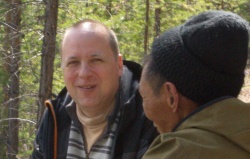In colloboration with the Department of Anthropology , Arctic Domus sponsored several seminars by distinguished speakers or by members of the project on research themes related to the project.
The talks were held on Thursdays in room F61 Edward Wright Building from 15.00-17.00 unless otherwise noted.
- 2016 Winter
-
18th February 2016 - Matei Candea

Matei Candea gave a formal talk on How anthropologists compare, how biologists doubt: Notes on the epistemic cultures of Social anthropology and Behavioural biology on 18 February.
Abstract
Much has been made in recent years of the way in which anthropological confrontations with alterity can generate productive conceptual uncertainty. This methodological infrastructure for the production of doubt can be thought of as a type of 'frontal' comparison in which a 'them' position is confronted to an 'us' position. This paper contrasts this methodological device with that of lateral comparisons, in which different cases are laid side by side. Frontal and lateral comparisons produce different, and complementary dynamics of conceptual uncertainty and productive doubt. The paper explores this question by thinking of anthropological comparison alongside the epistemic practices through which behavioural biologists produce and regulate doubt.
The seminar took place on 18 February (Thursday), F61.
11th February 2016 - David Koester

Dr. Koester gave a formal talk on Expressive Culture and Alienation in Kamchatka: Salmon in Itelmen Folklore and History on 11 February.
Abstract
Salmon have traditionally been immensely important as a subsistence resource for Itelmen people in the Russian Far East. Yet despite this central position, salmon were, until recently, remarkably little represented in Itelmen performative, expressive culture.

Over the years conceptual, economic, political and even ethnic modes or forms of alienation have increasingly separated Itelmen people from this traditionally inalienable resource. This presentation begins by exploring the extent to which salmon have been discussed, reflected in institutions and presented in Itelmen expressive culture. It then examines how various forms of separation have emerged to alienate Itelmens from this most traditional of resources.
The historical development and nature of these forms of alienation figure directly in Itelmens' current political struggle for resource rights, while at the same time salmon have shifted from essential subsistence background to culturally expressive foreground.
The seminar took place on 11 February (Thursday), F61.
Painting by V. Zaporotsky
4th February 2016 - Michaela Fenske

Dr. Fenskey gave a formal talk on Green Cities - Urban Natures? How citizens and honeybees arrange postmodern urbanity on the 4th of February.
Abstract
Since 2006 the so-called Colony Collapse Disorder (CCD), the decline of the European (or Western) Honeybee, is a widespread phenomenon in the western world. The public became aware of the honeybee's importance not only for the production of honey but also because for its pollination of vegetables, fruits, and other plants. As a consequence more and more people living in the metropoles and towns of industrialized countries in France, the USA, Great Britain, Austria, Switzerland or Germany practice urban beekeeping. Based on a case study of urban beekeeping in the German capital of Berlin, my project focuses on how the citizens use honeybees as new partners. Although the western honeybee has been domesticated since premodern times, some postmodern beekeepers interpret their bees as ambassadors of nature and teachers of sustainability. Honeybees are regarded as keystone animals for both the problems and the solution of the multiple crises at the beginning of the third millennium. My project aims to assess the complex question how, why, and in which contexts and milieus urban beekeeping has become in which manner important, and which aspects of the bee are regarded as relevant (e.g., bees as artisans, roboter-bees, beelarves as human nourishment, different kind of knowledge concerning bees etc.)? Another focus is concerned with the effects of the bees as new actors within urban settlements. What are the bees “doing” with human beings, how do they influence humans and their aspiration of inventing a better future? My internationally embedded case-study is conceived against the theoretical framework supplied by Human-Animal Studies, Multispecies Ethnography, Political Anthropology and Ecology, and Urban and Rural Studies. By applying different ethnological methods, the project will also demonstrate in which way anthropology may contribute to responding to the methodological challenges of research on human-animal interaction.
The seminar took place on 4 February (Thursday), F61.
- 2015 Winter - Summer
-
5th February 2015 - Marianne Lien

Marianne gave a formal talk Escapee, homeless and those that wander off: Salmon as rubble in Norwegian rivers on the 5th of February.
Abstract
In Norway, human and salmon have guided each others' lives in a fluid evolutionary tapestry that predates historical records. More recently, industrial development, hydroelectric power, and salmon farming have added new layers to this tapestry, and we see some salmon flourish while others are under threat. My paper traces salmon stories from the shores of the Vosso river, where the original Vosso salmon are returning in great numbers, as a result of recent cultivation efforts. Salmon returns provide not only prey for anxious anglers, but data too, and as such they help to 'domesticate' a river, making it legible for biologists in charge. In my paper I search for the cracks and the openings where the data become less certain, more indeterminate, and don't add up. Tracing the movements of salmon that 'wander off', I try to tell a story of the river that remains sensitive to the generative capacity of underwater lives.
The seminar took place on 5th February (Thursday), F61.
4th June 2015 - Charles Stépanoff

Charles gave a formal talk on The origins of reindeer-human co-domestication: Siberian mythologies and animal desire on the 4th of June.
Abstract
A growing number of authors are claiming that anthropology can no longer remain anthropocentrized, and should start taking seriously non-Western ontologies which recognize non-human perspectives. However, these kinds of studies often remain focused on human representations about non-humans, which may ironically produce anthropocentric accounts of non-anthropocentric ways of understanding.
In Siberia, reindeer herding groups are hybrid communities in which humans and animals adapt to each other and are bounded by shared familiar landscapes and nomadic routes. Nevertheless, most explanatory models of reindeer domestication are placing human strategies at the centre of the mechanism. A hybrid understanding is needed in order to account for the triadic dynamic interactions between human preferences, animal desires and landscape transformations. Taking seriously Siberian myths about domestic reindeer and associating them to reindeer ethology and new archeological approaches will help to produce a hybrid model of reindeer-human co-domestication.
The seminar took place on 4 June (Thursday), F61.
- 2014 Spring - Autumn
-
24th April 2014 - Hiroki Takakura

He gave a formal talk Horses as objects of carnivorous pastoralism. Multiple usage of species as an ecological adaptation in Siberia on the 24th of April.
Abstract
The human-animal relationship in the subsistence is not fixed but flexible to environmental and societal constraints. This lecture deals with the human adaptation through the cultural historical perspectives, focusing on the case of Sakha people in Siberia. The ethnic origin rooted in the region of the Baikal region in South Siberia and then moved toward the North. Through the historical migration, five species livestock husbandry typically seen in the steppe pastoralism had changed to the horse-cattle breeding in the subarctic condition. Correspondingly, the multiple usages on single species appeared in the breeding of horse. I describe their horse husbandry and compare it with the reindeer one of the Eveny as a neighboring ethnic group, which will show how the similar ecological setting forms the similar human-animal relations regardless the different historical background. Taking the biological feature of each animal into account, I consider the capacity of human adaptation in the North.
6th February 2014 - Ivar Bjorklund
Location: The Mission, St. Machar Drive Old Aberdeen, AB24 3RX

Abstract
Relations between humans and fish/animals are not only constituted by ecology and technology. It is a well known observation that also ideologies influence these relations. The ideological constructed transformation from household based pastoralism to kolkhoz-organized herding in the Soviet Union illustrates this point. Such changing value regimes also leads to recodification of the resource base, i.e. defining new kinds of ownership. The presentation is about how the development of a corporative society and a social-democratic ideology in Norway turned Sami resources like salmon and cod into Norwegian ownership while reindeer herding was considered an ethnofied resource and left to the Sami pastoralists. Thus the coastal Sami lost the possibility of self representation and self understanding through their own management of these species. It was not until the modernization ideology of the 1970-80's that also reindeer became subject to Norwegian control and a part of the general corporative economy and thus instrumental in a general assimilation process. Consequently, the reindeer herding Sami are in danger of losing the way they understand and present themselves; people in deep and profound relationships with the reindeer.
25th September 2014 - Dolly Jørgensen

Dolly also gave a formal talk The Shaggy Saviour of Northern Norway on the 25th of September.
Abstract
In 1929, 26 muskox calves were relocated from eastern Greenland to Svalbard, an archipelago in the Arctic Ocean under Norwegian sovereignty. The animals were let loose on the large island of Spitsbergen, which had historically been used primarily as a whaling station. In the relatively barren Svalbard landscape, the hope was that the muskoxen would turn into a self-reproducing meat resource for hunters and new settlers. The dream of muskox meat never became reality. Instead, the muskox was a protected animal on Svalbard, illegal to hunt, until the population crashed and eventually disappeared in the 1980s.
The Svalbard episode was only one of a series of attempts in northern Norway to introduce or reintroduce muskoxen as an economic good. In addition to attempts to introduce wild populations, wild-caught muskoxen were also relocated onto Norwegian farms as a new domestic animal from the 1960s. Struggling against the unruly nature of muskoxen as well as local residents, the new wool business never proved solvent.
This paper will examine the idea of making the north economically and ecologically productive through the import of muskoxen as both wild and domestic animals in Norway from the 1920s through 1980s. Both because of its meat and its highly prized wool coat, the muskox was envisioned as a savior for the economically challenged north. The repeated failures of the muskox projects, reconstructed from Norwegian archival documents and contemporary newspaper accounts, reveal how people can become enchanted with a vision of ecological improvement even when results continue to be dismal.
9th October 2014 - Jeff Kochan

Jeff gave a formal talk Scientific Styles in Northern Canada on the 9th of October.
Abstract
In the science studies literature, natural field sites are often treated as extensions of the laboratory. But this overlooks the unique specificities of field sites. Unlike the lab, the field is a public space inhabited by diverse people and groups. While lab scientists seek to contain and control their work spaces, field scientists must often adapt their work to the demands and interests of local agents. Lab studies regularly emphasise contestation; the field sciences more typically involve collaboration. I suggest that the difference between the lab and the field may be addressed as a difference in styles of reasoning. A field style treats epistemic alterity as a resource rather than an obstacle for objective knowledge production. A stylistics of the field should thus explain how objective science can co-exist with radical conceptual difference. I discuss examples from the Canadian North, focussing on collaborations between state wildlife biologists and managers, on the one hand, and local Aboriginal Elders and hunters, on the other. I argue that a stylistics of the field allows us to overcome issues of incommensurability, and to better understand how radically diverse agents may collaborate across cultures to produce reliable natural knowledge.
- 2013 Autumn - Winter
-
12th December 2013 - Fabiola Jara

The title of her paper is The forests' articulations along the nomadic hunting paths. Akuriyo practices in mimicry and sociality.
Abstract
The paper will talk about the specific notions and practices of the nomadic groups known as Akuriyo concerning their (animal) co-inhabitants in the forest of South Surinam. Using her own fieldwork data, and in the light of new insights on the ecology of Amazonian peoples concerning the transformation of the forest, Jara will discuss some concepts that could help us to understand better the nature of their social-ecology.
7th November 2013 - David G. Anderson

Abstract
The 'ontological turn' has reinvigorated the discussion of animism, personhood, among other classic topics in anthropology. These debates, however, never exactly return to the same origin point. The portrait of human-animal relations in many perspectivist or ANT-styled works display a radically narrow view of agency inter-preted as recalcitrance ('resistance') or as one of many homologous natures. This paper uses ethnographic examples primarily from an Evenki reindeer-herding commune in Eastern Siberia and from work with laboratory geneticists to examine how agency and intention flow in the management of reindeer estates. The paper will examine how both human intentionality and reindeer intentionality flow together into the creation of stocks, and how in turn ethnographic and laboratory techniques reduce these stocks into schemes. Given the length of the ethnographic tradition of documenting animism/agency, the paper argues for a richer ethnography of human-animal relations.
30th October 2013 - Prof. Rane Willerslev
(16.00-18.00 at New King's 14)

Abstract Why is it that some cultures across time and place engage in the ritual killing of a close family member? For we may ask: What is the logic behind such human sacrifices and what kinds of religious values are at stake? In this talk, two apparently different sacrificial traditions are compared: the well-known story of Abraham's near-sacrifice of Isaac and the sacrificial practice of the Siberian Chukchi, who kill their elderly on the latter's own request. At first glance, it appears as though these two traditions differ quite sharply in what they posit as the value of sacrifice. The binding of Isaac is often interpreted as a story about the ultimate act of faith.
The Chukchi, by contrast, emphasize utility as the major goal of sacrifice and even use trickery to this end. Drawing on the Dumontian idea that a dominant value contains its contrary within, Willerslev shows that what counts as the dominant value in each of the two sacrificial traditions is so deeply co-implicated that trickery (Chukchi) becomes the shadow of faith (Abraham), and vice versa. At certain moments, one dominant value or the other is captured by its own shadow and flips into its contrary. This reversibility takes place against a “paramount value” shared by both traditions: the necessary hierarchical distance between humanity and divinity. All of this allows us to reinterpret Abraham's trial in a manner that is precisely contrary to most prevailing interpretations—namely, as an act in which God is put on trial by Abraham. The radical comparative exercise also allows us to explain the basic logic behind human sacrifice.
10th October 2013 - Dr. Craig Mishler

Abstract
Like the bowhead whale is to the Iñupiat, or the buffalo is to the Plains Indians, vadzaih (Rangifer Tarandus) is a staple of Gwich'in subsistence and spirituality. Over the millennia, the Gwich'in people of northeast Alaska and northwest Canada have developed a detailed knowledge of caribou body parts to the extent that virtually every bone, muscle, and internal organ is an exciting point of entry into the culture. Dr. Mishler's talk offers insights into an indigenous ontology, one which weds science and the humanities, osteology and verbal art.
25th September 2013 - Prof. Patricia McCormack
(14.00 in 'the North' seminar room, 24 High Street)

Abstract Dogs have co-existed with people of the boreal forest as long as humans have been able to live in these northern lands, and even today the image of dog teams and their drivers is a strong icon of the Canadian north. Yet such dog teams were not a common practice by Subarctic peoples until the advent of the European fur trade created a new fur trade mode of production. Small teams of dogs then began to be used to haul sleds in winter.
This paper considers this transition and the subsequent growth in the size of the teams and changes in sled technology. It includes a focus on John Rae's use of dogs and sleds in the western Subarctic in the mid 19th century. Finally, it discusses how this new role for dogs was related to a series of other changes for both Aboriginal trappers and European traders in technology, economy, residence pattern, gender roles, and even ideology.
- 2012 - 2013
-
8 March 2013 - Jürg Endres
 Mr. Jürg Endres is a PhD candidate at the Free University of Berlin. He has conducted long-term fieldwork among the reindeer herding Duka of Northern Mongolia and the Todzhu of Tuvan Russia focusing on their ecological relationships. He gave a lecture entitled The Dukha and the Todzhu and consulted with our project group.
Mr. Jürg Endres is a PhD candidate at the Free University of Berlin. He has conducted long-term fieldwork among the reindeer herding Duka of Northern Mongolia and the Todzhu of Tuvan Russia focusing on their ecological relationships. He gave a lecture entitled The Dukha and the Todzhu and consulted with our project group.Abstract
The Dukha, who nomadise in the forests and mountains of the northernmost corner of Mongolia, and the Todzhu, who live just across the border in the Tuva Republic of the Russian Federation, are two closely related groups of ethnic Tuvan reindeer herder-hunters who became separated from each other only as recently as the 1950s, when the long process of delineating the border between Tuva, or by that time rather the Soviet Union, and Mongolia was completed. The two groups live in environments which are ecologically virtually identical, and share the same culture, religion, language and traditional economy. Ever since this separation, however, they have been living in two distinctively different political and legal environments, and this has cast them onto two quite different development trajectories. The lecture seeks to isolate and compare the specific effects of mostly political factors on the vulnerability and resilience of both groups, mainly by taking a look at how these have had an impact on their adaptive capacity, livelihood strategies and cultural transmission mechanisms. It hereby also aims at exploring (and perhaps expanding) the limits of contemporary frameworks such as resilience theory which has recently been criticised by political ecologists for not engaging enough with issues of policy and power.
4- 8 November 2012 - Dr. Hiroko Ikuta

Dr. Ikuta held one informal seminar on the State of Alaska policies for subsistence with a special focus on fishing quotas. She also worked closely with many members of the project who are working together on the Yukon-Alaska region.
